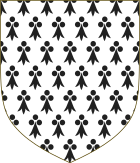The Capetian dynasty, also known as the House of France, is a dynasty of Frankish origin, and a branch of the Robertians agnatically, and the Karlings through female lines. It is among the largest and oldest royal houses in Europe and the world, and consists of Hugh Capet, the founder of the dynasty, and his male-line descendants, who ruled in France without interruption from 987 to 1792, and again from 1814 to 1848. The senior line ruled in France as the House of Capet from the election of Hugh Capet in 987 until the death of Charles IV in 1328. That line was succeeded by cadet branches, the Houses of Valois and then Bourbon, which ruled without interruption until the French Revolution abolished the monarchy in 1792. The Bourbons were restored in 1814 in the aftermath of Napoleon's defeat, but had to vacate the throne again in 1830 in favor of the last Capetian monarch of France, Louis Philippe I, who belonged to the House of Orléans. Cadet branches of the Capetian House of Bourbon are still reigning over Spain and Luxembourg.

The Duchy of Brittany was a medieval feudal state that existed between approximately 939 and 1547. Its territory covered the northwestern peninsula of Europe, bordered by the Atlantic Ocean to the west, and the English Channel to the north. It was also less definitively bordered by the river Loire to the south, and Normandy, and other French provinces, to the east. The Duchy was established after the expulsion of Viking armies from the region around 939. The Duchy, in the 10th and 11th centuries, was politically unstable, with the dukes holding only limited power outside their own personal lands. The Duchy had mixed relationships with the neighbouring Duchy of Normandy, sometimes allying itself with Normandy, and at other times, such as the Breton–Norman War, entering into open conflict.

Peter I, also known as Peter Mauclerc and Peter of Dreux, reigned as Duke of Brittany alongside his wife Alix from 1213 to 1221, and was regent of the duchy for his minor son John I from 1221 to 1237. As duke he was also 1st Earl of Richmond from 1218 to 1235.
In heraldry, variations of the field are any of a number of ways that a field may be covered with a pattern, rather than a flat tincture or a simple division of the field.

Alix was Duchess of Brittany from 1203 until her death. She was also Countess of Richmond in the peerage of England.
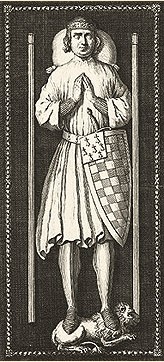
Arthur II, of the House of Dreux, was Duke of Brittany from 1305 to his death. He was the first son of John II and Beatrice, daughter of Henry III of England and Eleanor of Provence.
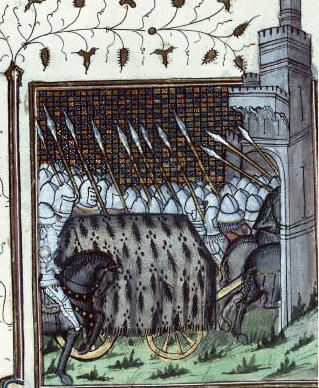
John III the Good was Duke of Brittany, from 1312 to his death and 5th Earl of Richmond from 1334 to his death. He was the son of Arthur II, Duke of Brittany, and his first wife Marie, Viscountess of Limoges. John was strongly opposed to his father's second marriage to Yolande and attempted to contest its legality.
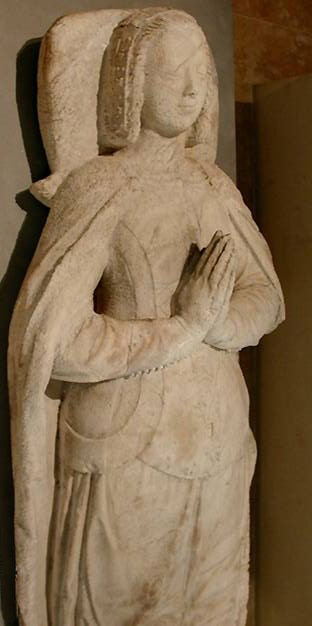
Joan of Penthièvre reigned as Duchess of Brittany together with her husband, Charles of Blois, between 1341 and 1364. Her ducal claims were contested by the House of Montfort, which prevailed only after an extensive civil war, the War of the Breton Succession. After the war, Joan remained titular Duchess of Brittany to her death. She was Countess of Penthièvre in her own right throughout her life.
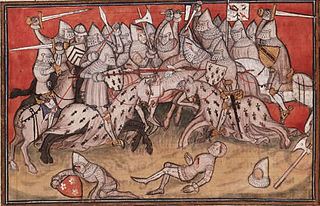
The War of the Breton Succession was a conflict between the Counts of Blois and the Montforts of Brittany for control of the Duchy of Brittany, then a fief of the Kingdom of France. It was fought between 1341 and 12 April 1365. It is also known as the War of the Two Joans due to the involvement of two rival duchesses of that name.

John of Montfort, sometimes known as John IV of Brittany, and 6th Earl of Richmond from 1341 to his death. He was the son of Arthur II, Duke of Brittany and his second wife, Yolande of Dreux. He contested the inheritance of the Duchy of Brittany with his niece Joan of Penthièvre, which led to the War of the Breton Succession, which in turn evolved into being part of the Hundred Years' War between England and France. John's patron in his quest was King Edward III of England. He died in 1345, 19 years before the end of the war, and the victory of his son John IV over Joan of Penthièvre and her husband, Charles of Blois.

The now-extinct title of Earl of Richmond was created many times in the Peerage of England. The earldom of Richmond was initially held by various Breton nobles; sometimes the holder was the Breton duke himself, including one member of the cadet branch of the French Capetian dynasty. The historical ties between the Duchy of Brittany and this English earldom were maintained ceremonially by the Breton dukes even after England ceased to recognize the Breton dukes as earls of England and those dukes rendered homage to the King of France, rather than the English crown. It was then held either by members of the English royal families of Plantagenet and Tudor, or English nobles closely associated with the English crown. It was eventually merged into the English crown during the reign of Henry VII of England and has been recreated as a Dukedom.

Joan of Flanders was duchess of Brittany by her marriage to John of Montfort. Much of her life was taken up in defense of the rights of her husband and, later, son to the duchy, which was challenged by the House of Blois during the War of the Breton Succession. Known for her fiery personality, Joan led Montfort's cause after her husband had been captured by Philip VI of France, and began the fight back. There, she displayed considerable skill as a military leader and gained the respect of her people.

In the 11th and 12th centuries the Countship of Penthièvre in Brittany belonged to a branch of the sovereign House of Brittany. It initially belonged to the House of Rennes. Alan III, Duke of Brittany, gave it to his brother Eudes in 1035, and his descendants formed a cadet branch of the ducal house.
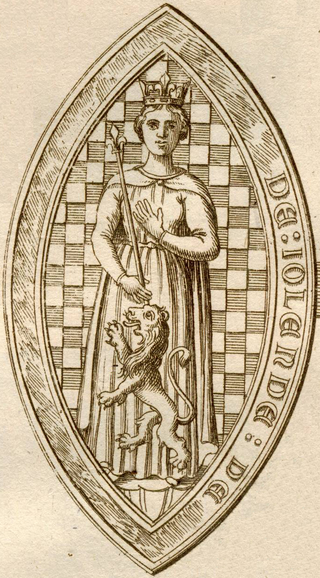
Yolande of Dreux was a sovereign Countess of Montfort-l'Amaury from 1311 until 1322. Through her first marriage to Alexander III of Scotland, Yolande became Queen of Scotland. Through her second marriage to Arthur II, Duke of Brittany, she became Duchess of Brittany.

The House of Montfort-Brittany was a Breton-French noble family, which reigned in the Duchy of Brittany from 1365 to 1514. It was a cadet branch of the House of Dreux; it was thus ultimately part of the Capetian dynasty. It should not be confused with the older House of Montfort which ruled as Counts of Montfort.
The crown lands, crown estate, royal domain or domaine royal of France were the lands, fiefs and rights directly possessed by the kings of France. While the term eventually came to refer to a territorial unit, the royal domain originally referred to the network of "castles, villages and estates, forests, towns, religious houses and bishoprics, and the rights of justice, tolls and taxes" effectively held by the king or under his domination. In terms of territory, before the reign of Henry IV, the domaine royal did not encompass the entirety of the territory of the kingdom of France and for much of the Middle Ages significant portions of the kingdom were the direct possessions of other feudal lords.

Yolande of Brittany, also known as Yolande de Dreux, was the ruler of the counties of Penthièvre and Porhoet in the Duchy of Brittany. Yolande had been betrothed to King Henry III of England in 1226 at the age of seven years, but married Hugh XI of Lusignan, the half-brother of Henry III. Through Hugh, she became Countess of La Marche and of Angoulême. She was the mother of seven children. From 1250 to 1256, she acted as Regent of La Marche and Angoulême for her son, Hugh XII of Lusignan.
Constance of Penthièvre was a Breton princess, daughter of Alan of Penthièvre, 1st Earl of Richmond, and Bertha of Cornouaille, suo jure Duchess of Brittany.

John I, was Count of Penthièvre and Viscount of Limoges from 1364 to 1404, and the Penthièvre claimant to the Duchy of Brittany.




